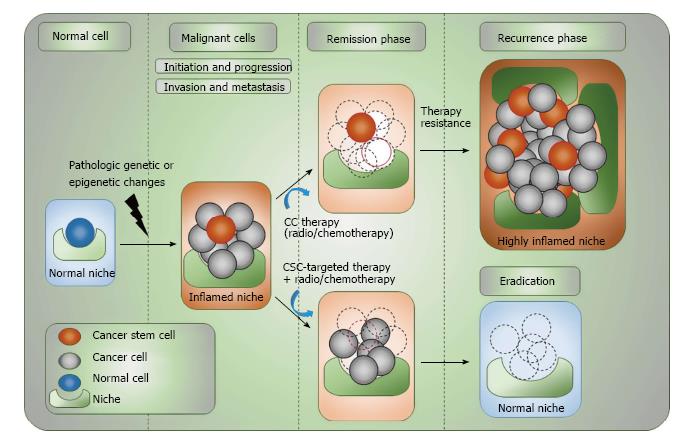Copyright
©The Author(s) 2017.
World J Stem Cells. Oct 26, 2017; 9(10): 169-178
Published online Oct 26, 2017. doi: 10.4252/wjsc.v9.i10.169
Published online Oct 26, 2017. doi: 10.4252/wjsc.v9.i10.169
Figure 1 Complex organization of cancer initiation, progress, remission and relapse.
CSCs are capable of undergoing extensive cell proliferation after acquiring different pathologic genetic/epigenetic changes while retaining their stemness and giving rise to differentiated progenies. Acquiring further genetic/epigenetic changes during different stages of tumor progression will evolve CSCs, but this may also be advanced through having dynamic interplay with the stem cell-niche. Both CSCs and non-CSCs can be found at the invasive front of primary tumors, which is linked to the process of EMT. However, only CSCs are capable of surviving from immune-surveillance or conventional tumor therapies and are able to give rise to distance metastasis or cause cancer recurrence. The potential eradication of tumor cells and CSCs can be resulted only upon combination targeted therapeutic approaches. Tumor stem cell-targeting drugs should able to prolong the efficacy of cytotoxic tumor therapy and reduce the recurrence risk. CSC: Cancer stem cell; CC: Cancer cell; NC: Normal cell; EMT: Epithelial-mesenchymal transition.
- Citation: Radpour R. Tracing and targeting cancer stem cells: New venture for personalized molecular cancer therapy. World J Stem Cells 2017; 9(10): 169-178
- URL: https://www.wjgnet.com/1948-0210/full/v9/i10/169.htm
- DOI: https://dx.doi.org/10.4252/wjsc.v9.i10.169









